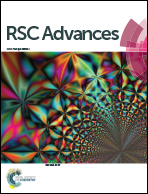Critical role of silk fibroin secondary structure on the dielectric performances of organic thin-film transistors†
Abstract
Silk fibroin (SF) is being considered as an emerging class of dielectric material in electronics, such as organic thin-film transistors (OTFTs). SF has several advantageous properties, including high transparency, flexibility, and solution-processibility. In this study, we investigated the effects of processing solvent and post-treatment on the surface properties and structural development of SF films, which were used in the gate-dielectric of OTFTs. The SF films cast from aqueous solution exhibited an amorphous structure with random coil conformations, leading to poor dielectric properties that were inadequate for developing OTFTs. In contrast, the use of formic acid solution and sequential methanol vapor treatment after film casting induced a smoother SF surface. Moreover, its crystallinity also improved dramatically. Furthermore, the SF films cast from formic acid solution and treated with methanol vapor were capable of growth of highly ordered organic semiconductor thin films deposited on these films. As a result, pentacene TFTs fabricated with the SF films showed high performance and stable operation with nearly zero turn-on voltage, negligible hysteresis, and high bias stability. This indicates a strong correlation between the structure of the SF film and dielectric performances of OTFTs. We believe that our study would be useful in designing silk materials, which are highly compatible with the human interface and other biological environments.


 Please wait while we load your content...
Please wait while we load your content...